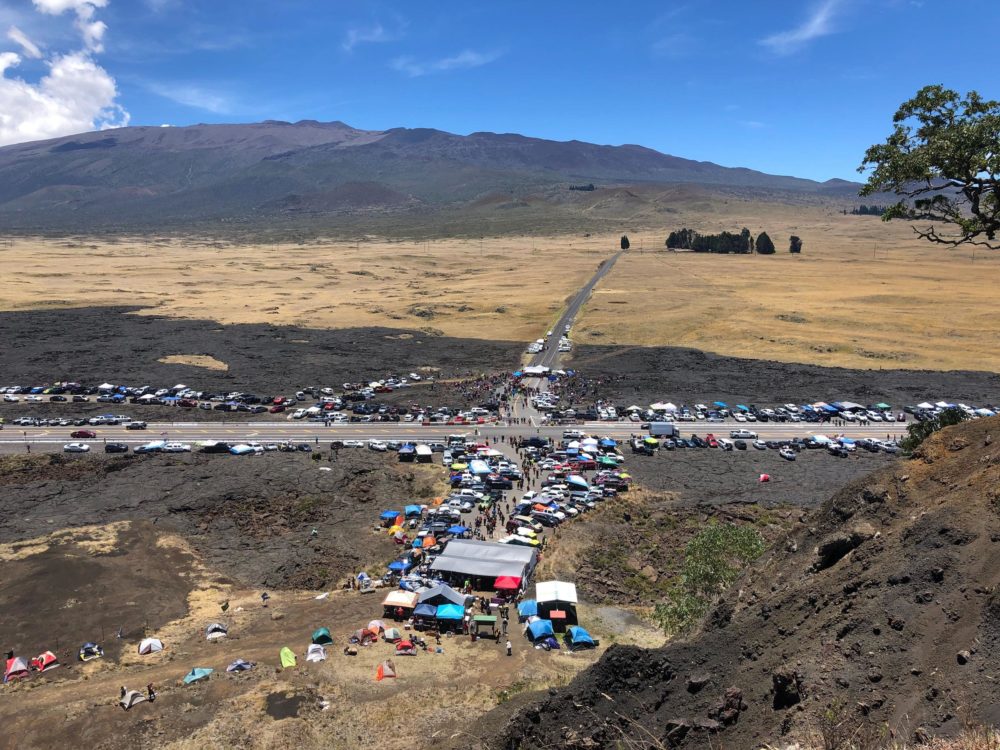By Devendra Dubey
BOSTON–When the mountain Manua Kea was selected by a team of eminent astronomers, as the site for one of the world’s largest and most powerful telescopes, the thirty meter Telescope, known as TMT, the astronomy community was very excited.
This site was unique because the low background of light, clear and dry air. Mauna Kea is also unique among astronomy sites around the world because it is in the middle of the Pacific Ocean. This means airflow across the ocean is unobstructed before reaching the mountain, causing the air on the mountain to be less turbulent and thus better for astronomical viewing than other observing sites.

The TMT project is an international partnership between the California Institute of Technology, Universities of California and Hawaii in the US, Canada, China, Japan and India. TMT India is a consortium that consists mainly of the Aryabhatta Research Institute for Observational Sciences, the Indian Institute of Astrophysics, and the Inter-University Center for Astronomy and Astrophysics, and is financially supported by the Departments of Atomic Energy, and Science and Technology of India. TMT India plays a vital role and is already working on the assembly of the TMT telescope.
But the project, however, might be in jeopardy.
In 2018, a poll conducted by Mason-Dixon Polling & Strategy showed that the majority of people in Hawaii, including a majority of Native Hawaiians, support the construction of the telescope at the proposed site on Mauna Kea (https://www.westhawaiitoday.com/2018/03/26/hawaii-news/poll-shows-strong-public-for-thirty-meter-telescope/).
Nevertheless, people opposed to the telescope filed a petition that construction of the telescope will (a) infringe on the cultural and religious rights, (b) substantially affect endangered species, and (c) harm the water supply. After a 44-day hearing held before hearing officer and retired judge Riki May Amano, it was concluded that none of the above objections are valid.
These findings were further upheld by the Supreme Court of the State of Hawaii in a 4-1 ruling in late 2018.
Who are the people opposing the construction of the telescope at the Mauna Kea site and why?
A review of the statements made by a core group of protesters clearly shows that some people are opposed to building TMT because they want to return to the Kingdom of Hawaii. These protests against telescope can be viewed as being partially about the Hawaiian sovereignty movement, in addition to or as subtext for sacred land or culture.
Many of these protesters are supporting secession from the United States and away from democracy. Some evidence for this was seen when an anti-telescope party during the hearing attempted to offer a law professor from the William S. Richardson School of Law to testify that the Kingdom of Hawaii still has title to the land and that the state has no right to give TMT the land to build on www.youtube.com/watch?v=VpXayTDmDgo&list=PLJoDubzll-huSjqB6gUvbDyibi-S-fwlZ&index=87. The hearing officer rejected the offer as not germane. This idea indicates the (political) motivation of some of the anti-TMT protesters.
Another argument against building the TMT at the Mauna Kea site is the claim that it has been a traditionally sacred place for Native Hawaiians. This claim may be true for some. However, when TMT is completed, it will occupy less than 0.05% of the Mauna Kea Science Reserve at the summit. There is room for both astronomy and the beliefs of people to co-exist.
Still, people’s beliefs about Mauna Kea can and should be respected and considered by others, including TMT, which has done so.
Based on input from local community engagement, TMT is to be placed away from culturally sensitive areas and is not on any known burial grounds. That engagement also helped partially guide design of the telescope. Additionally, TMT has also contributed $7.6 million to STEM initiatives for Hawaii Island students since 2014.
Given these facts, it is strange that some in the Democratic party, including some presidential candidates like Elizabeth Warren and Tulsi Gabbard, as well as the media, have shown bias in favor of the protesters.
There have been demonstrations both against as well as in favor of the TMT. Invariably little mention of the demonstrations in favor has been reported. The media has also not made any effort to inform the public about the political motivations of many of the anti-TMT protesters, who are currently physically blocking the road to the summit so construction can’t begin.
It is tragic that Democratic leadership is betraying the people of Hawaii for political gain. The leadership is not honest by not telling their supporters why they are buttressing the protesters, by not giving the facts.
TMT is an instrument to explore the universe. All cultures, ancient or modern, have since time immemorial looked at celestial objects, the sun, planets, and stars, with great reverence and awe because they believe that the secret of their being resides in there. TMT may help understand that secret.
TMT is not an instrument of exploitation but a tool that helps find our origin.
Locating TMT in Hawaii will not only help Hawaii economically and in education but also impact the Hawaiian society in a very profound way.
“Devendra Dubey, a retired scientist, was affiliated with Dana Farber Cancer Research Institute and Harvard Medical School. Opinion expressed in this article is his own personal view.)














